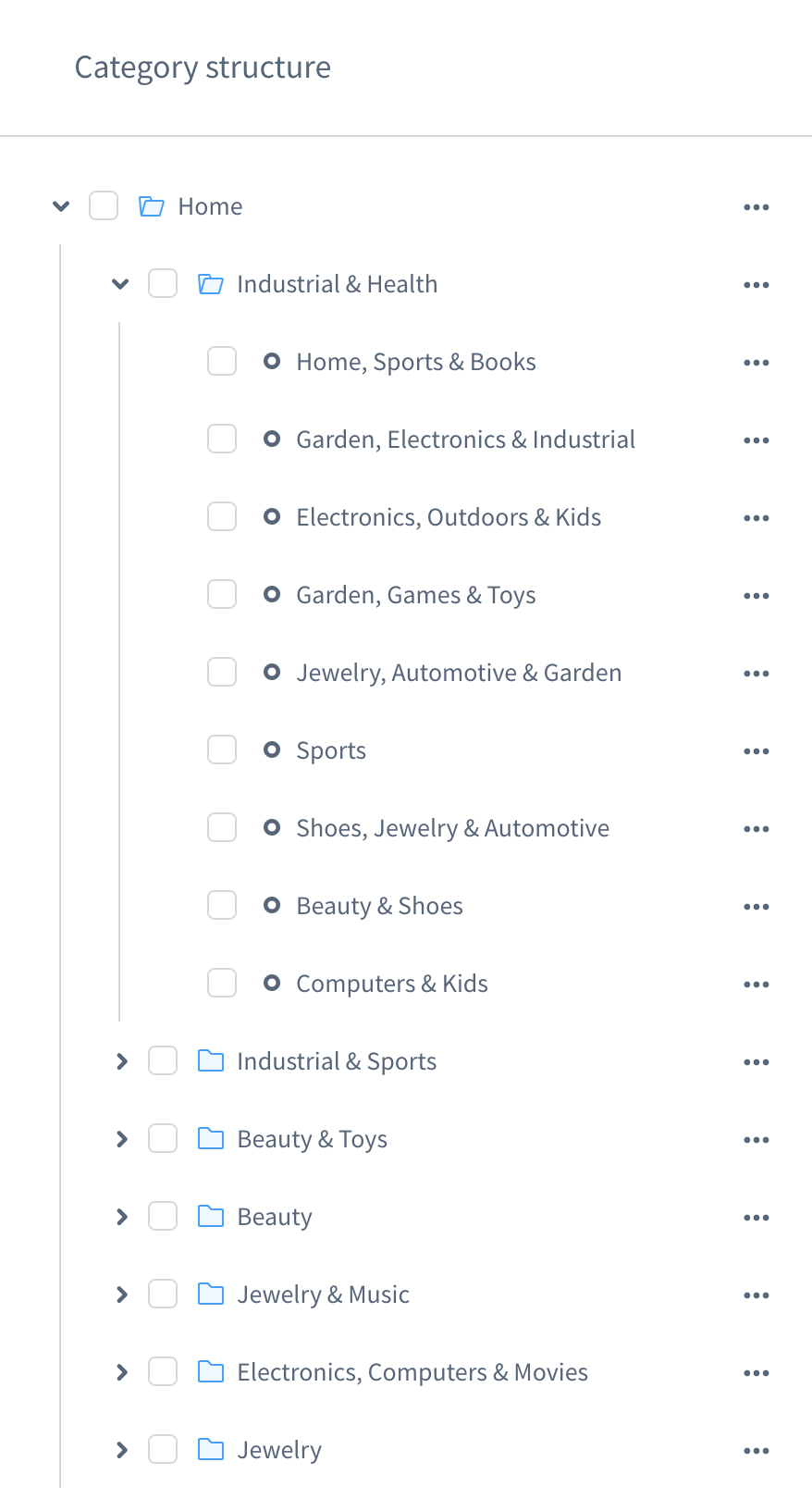Categories
Categories in Shopware organize products, drive storefront navigation, and define SEO-relevant URLs. The entire catalog lives in one category tree, and every sales channel chooses entry points inside that tree. For how to use the Admin UI, see the user documentation on categories and Dynamic Product Groups. This page focuses on developer details.

Category model and tree
- Each category stores
parentId,path, andlevelto build breadcrumbs, infer inheritance, and traverse efficiently. - Flags:
activedetermines whether the category participates in navigation and listings.visibleandhideInNavigationcontrol menu rendering without disabling the category entirely.
- Types:
page: regular category (listing or landing page).folder: structuring element; not rendered as a page and typically used to group children.link: redirects to an external URL or internal static link.
Entity associations and database schema
category: tree structure pluscmsPageIdfor layout inheritance;productAssignmentTypecontrols explicit vs. stream-based listings.category_translation: localized names, breadcrumbs, links, and SEO text.product_category: explicit product links used for listings when not driven by a product stream.product_stream: dynamic filters attached to a category when assignments are stream-based.cms_page: CMS layout referenced by categories (inherited when missing).sales_channel: entry categories (navigation,footer,service) anchoring storefront menus.seo_url: generated URLs per category and sales channel domain, rebuilt by the SEO indexer.
Sales channel entry points and navigation
Every Sales Channel defines navigation, footer, and service entry categories. The storefront builds menus from the children of those entry points, inheriting explicit assignments from lower levels.
Store API endpoints:
/store-api/navigation/{activeId}/{rootId}for hierarchical menus./store-api/category/{navigationId}for category details including assigned CMS layout data.
Navigation responses are cached. Adjust cache identity or tags via NavigationRouteCacheKeyEvent and NavigationRouteCacheTagsEvent. Use NavigationLoadedEvent to enrich or modify the tree before it is returned.
INFO
Categories can be hidden from navigation via the hide-in-navigation flag while remaining reachable by direct URL if they are still active.
Product assignments and Dynamic Product Groups
- Explicit assignments: stored in
product_category(andproduct_category_treefor inherited links) to put category IDs directly on products. - Dynamic Product Groups (product streams): attached to a category to evaluate saved filters at runtime and automate listings (for example, brand filters or price ranges). See the user docs for configuration guidance.
Both assignment types are merged for a category listing. ProductListingRoute builds the listing criteria from the category configuration, sales channel, and request filters. Extend or alter the listing query with ProductListingCriteriaEvent.
CMS layout integration
Categories can reference a CMS layout. Layout selection is inherited: if cmsPageId is missing, the parent layout is used. Category-specific slot configuration is stored on the category and merged at runtime, so one layout can serve many categories with different media and copy. folder categories ignore layouts; link categories redirect immediately.
SEO and URLs
Per-category SEO fields include metaTitle, metaDescription, keywords, seoUrl, and robot flags (noIndex, noFollow). SEO URLs are generated from templates under Settings → SEO and are rebuilt when categories change or when the SEO indexer runs.
- Customize URL templates (e.g., include the breadcrumb) and priorities per sales channel domain.
- React to regenerated URLs via
SeoUrlUpdateEvent, or enqueue additional updates when categories are changed programmatically. - Emit canonical links when rendering custom category pages.
Extensibility and events
NavigationLoadedEvent: navigation tree loaded; enrich or adjust nodes.SalesChannelCategoryIdsFetchedEvent: category IDs resolved for a sales channel.CategoryIndexerEvent: keep de-normalized data or external search indices in sync.ProductListingCriteriaEvent: customize listing filters, sorting, and aggregations for category pages.SeoUrlUpdateEvent: observe or react to SEO URL regeneration.
Categories are fully extensible via custom fields or entity extensions. Expose custom data through Store API response extensions when it is needed in storefronts or external channels.